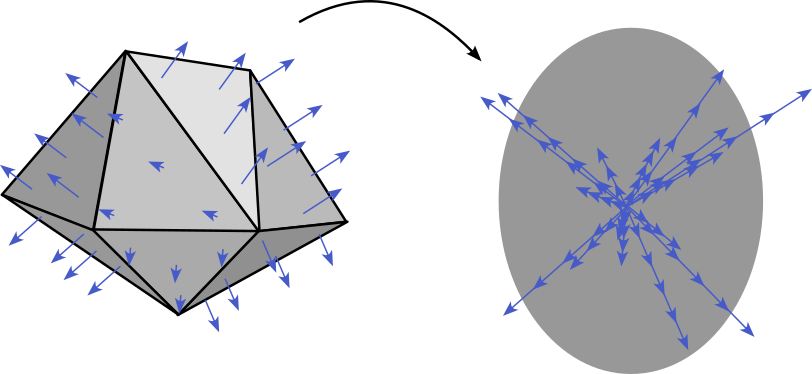In three dimensions, irreducible Minkowski tensors (IMT’s) are defined by an expansion of the density of surface normal directions, in complete analogy to the two-dimensional case. The distribution of surface normals uniquely determines a convex object. (This statement is known as Minkowski’s problem. In this context, the surface normal density is sometimes called the extended Gaussian image. [bibcite key=horn1984egi])
It is useful to select the complete orthogonal set of Spherical harmonics as basis functions. For a polyhedron with face areas ![]() and normals
and normals ![]() , the IMT’s are given by
, the IMT’s are given by
![]() .
.
Here ![]() is the obvious notation for the spherical harmonic evaluated with the direction corresponding to the normal
is the obvious notation for the spherical harmonic evaluated with the direction corresponding to the normal ![]() . The index
. The index ![]() labels increasing tensor ranks, and
labels increasing tensor ranks, and ![]() is the “magnetic quantum number”. The complex coefficients
is the “magnetic quantum number”. The complex coefficients ![]() have the usual transformation properties of spherical harmonics under rotations.
have the usual transformation properties of spherical harmonics under rotations.
Often, it is useful to define rotational invariants which can serve as fingerprints of a body irrespective of its orientation in space. The quadratic invariants in particular are
![]() .
.
For convenience, we have also divided by the total surface area, such that the ![]() are invariant under translation, rotation, and scaling.
are invariant under translation, rotation, and scaling.
Three-dimensional irreducible Minkowski Tensors are discussed in greater detail in Ref. [bibcite key=mickel2013shortcomings]. When computed for Voronoi cells, they generalize Paul Steinhardt’s bond-orientational order parameters [bibcite key=steinhardt1983bond-orientational].